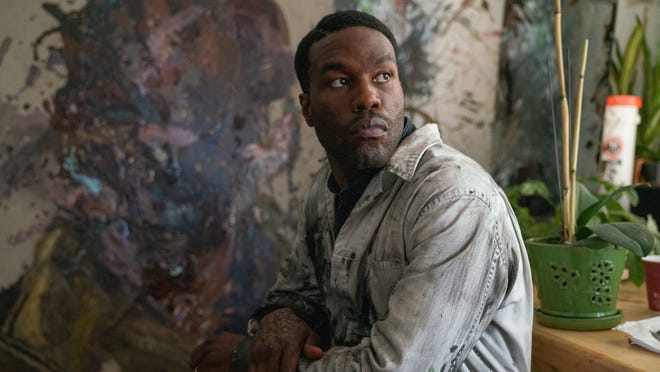
After being hyped for what turned into a couple of years due to the ongoing COVID-19 pandemic, finally the anticipated newest entry in the Candyman franchise has arrived onscreen. This one features a rising director at the helm, a rising star as its lead, and is produced by probably the biggest name in prestige horror film at the moment. But do all of these factors equal into a film that sticks its landing?
Candyman returns us to the city of Chicago, one decade after the last of the Cabrini Green housing project towers were torn down. Aspiring artist Anthony McCoy (Yahya Abdul-Mateen II) and his girlfriend Brianna Cartwright (Teyonah Parris) occupy the loft condominiums in the now gentrified former projects. In search of inspiration for his next pieces after a visit from Brianna’s brother Troy (Nathan Stewart-Jarrett) who tells them about Candyman, Anthony has a chance encounter with Cabrini old-timer William Burke (Colman Domingo) who tells his the true story behind the urban legend. As Anthony delves deeper into the legend, he unknowingly opens a door to a complex past that unravels his own sanity and unleashes a terrifying wave of violence.
In this reviewer’s estimation, films are generally better when they have a point or something that the filmmaker wishes to communicate to an audience using the story and its characters as conduits. Film is uniquely capable of evoking empathetic reactions in audiences while driving home messages or putting society’s issues under a microscope. However, when a film decides to lean into examining social issues, the issue of how subtly it does so is paramount. Thematically, director/co-writer Nia DaCosta uses the Candyman mythos and to examine generational and historical trauma, such as lynchings and brutality against blacks, and how we attempt to bury the pains of the past to our shared detriment, not entirely unlike how the original film handled the issue of traumatic tourism among wealthy whites when it comes to the brutality that impoverished black Americans have faced through the centuries in the western world.
The current iteration slightly tweaks the mythos of the character and the world it inhabits by explaining that Candyman is a moniker shared and passed down throughout the history of the United States by black men victimized at the hands of a prejudiced and exploitative society rather than one solitary man’s story. Candyman’s murderous vengeance from beyond the grave spurred by the evocation of his memory is aimed at a society that tries to forget its misdeeds, serving as a reminder of the bad deeds that were, even when society would rather forget. This tendency among human beings to attempt to erase the trauma of the past is explored further among the film’s characters from Anthony and his mother’s past in the city as a younger family to Brianna’s unresolved issues surrounding the suicide of her artist father. The burial of their pain and refusal to come to terms with the lingering after effects of their experiences only serves to exacerbate the problems all of them face as the film progresses, mirroring what our own society faces when it refuses to confront the sins of the past.
All of this was communicated well through both exposition and character story and development throughout the majority of the film, until its final moments when conveyance of its themes suddenly switched from the subtlety of a feather’s touch to the force of a sledgehammer. While I won’t go into detail on what exactly transpires, generally speaking it takes a bizarre 180 degree turn from a psychological horror film with some slightly on the nose social commentary to a full-on, in your face horror spin on the historical issues surrounding police brutality and misconduct that our nation has grappled with over the past year. The decision to delve into this topic with such a heavy and obvious hand only serve to highlight the film’s issues throughout with surface level commentary on issues such as gentrification and slightly convoluted character motivations from the film’s ultimate villain. What came before the ending had just enough subtlety to be interesting, such as the back and forth between Anthony and film critic Finley Stephens (Rebecca Spence) that examined white criticism of black art, but suddenly became glaring oversights with the choice to loudly comment on police brutality at the last moment.
One aspect of the film that is consistent throughout is the eye-catching imagery employed by DaCosta and director of photography John Guleserian. The film is a visual delight from its opening credits that cleverly play off of the importance of mirrors to the Candyman mythos by displaying them backwards to the silhouette imagery used to explain backstory and history, to the creative use of mirrors to stage scenes and characters. The parallel physical deterioration that Anthony experiences alongside his mental descent following a bee sting when he first visits the remnants of Cabrini is expertly crafted by the film’s makeup team, but other than a few moments of gore, the film eschews straightforward horror for that of the psychological variety. And this is what ultimately holds Candyman back from realizing any potential it has in full. It’s messages and themes are cluttered and varying, ranging from underexamined to too in your face and obvious. That the horror elements that helped make the original so beloved are removed in favor of inconsistent social commentary only makes the film’s flaws more glaring. What we’re left with is a film that trips over itself and ultimately leaves much on the table.
Image: Universal Pictures

